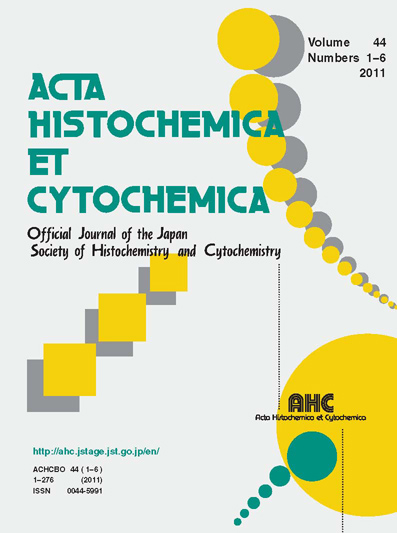巻号一覧

42 巻, 1 号
選択された号の論文の2件中1~2を表示しています
- |<
- <
- 1
- >
- >|
REGULAR ARTICLE
-
Tetsuji Mori, Taketoshi Wakabayashi, Yasuharu Takamori, Kotaro Kitaya, ...2009 年42 巻1 号 p. 1-8
発行日: 2009年
公開日: 2009/02/28
[早期公開] 公開日: 2009/02/17ジャーナル フリーIn intact adult mammalian brains, there are two neurogenic regions: the subependymal zone and the subgranular layer of the hippocampus. Even outside these regions, small numbers of proliferating precursors do exist. Many studies suggest that the majority of these are oligodendrocyte precursors that express NG2, a chondroitin sulfate proteoglycan, and most of the residual proliferating cells seem to be endothelial cells. However, it is still unclear whether NG2-immunonegative proliferating precursors are present, because previous studies have neglected their possible existence. In this study, we systematically analyzed the phenotypes of the proliferating cells in the intact adult rat cortical gray matter. We improved our techniques and carefully characterized the proliferating cells, because there were several problems with identifying and quantifying the proliferating cells: the detection of NG2-expressing cells was dependent on the fixation condition; there were residual proliferating leukocytes in the blood vessels; and two anti-NG2 antibodies gave rise to different staining patterns. Moreover, we used two methods, BrdU and Ki67 immunostaining, to quantify the proliferating cells. Our results strongly suggest that in the intact adult cerebral cortical gray matter, there were only two types of proliferating cells: the majority were NG2-expressing cells, including pericytes, and the rest were endothelial cells.
抄録全体を表示PDF形式でダウンロード (1068K) -
Yuko Iida, Toshiyuki Matsuzaki, Tetsuro Morishima, Hiroshi Sasano, Kiy ...2009 年42 巻1 号 p. 9-14
発行日: 2009年
公開日: 2009/02/28
[早期公開] 公開日: 2009/02/25ジャーナル フリーReversion-induced LIM protein (RIL) is a member of the ALP (actinin-associated LIM protein) subfamily of the PDZ/LIM protein family. RIL serves as an adaptor protein and seems to regulate cytoskeletons. Immunoblotting suggested that RIL is concentrated in the astrocytes in the central nervous system. We then examined the expression and localization of RIL in the rat central nervous system and compared it with that of water channel aquaporin 4 (AQP4). RIL was concentrated in the cells of ependyma lining the ventricles in the brain and the central canal in the spinal cord. In most parts of the central nervous system, RIL was expressed in the astrocytes that expressed AQP4. Double-labeling studies showed that RIL was concentrated in the cytoplasm of astrocytes where glial fibrillary acidic protein was enriched as well as in the AQP4-enriched regions such as the endfeet or glia limitans. RIL was also present in some neurons such as Purkinje cells in the cerebellum and some neurons in the brain stem. Differential expression of RIL suggests that it may be involved in the regulation of the central nervous system.
抄録全体を表示PDF形式でダウンロード (1024K)
- |<
- <
- 1
- >
- >|